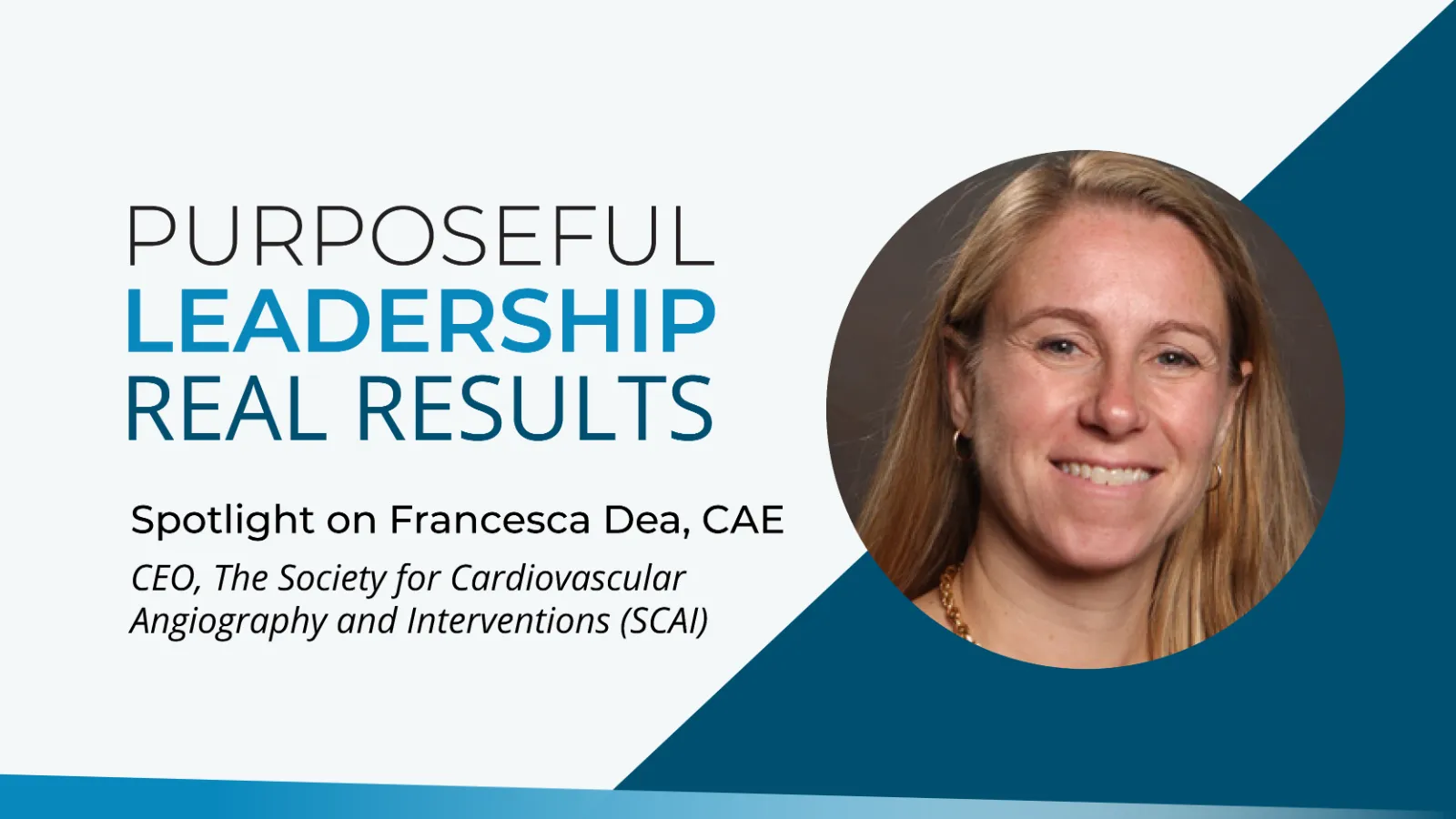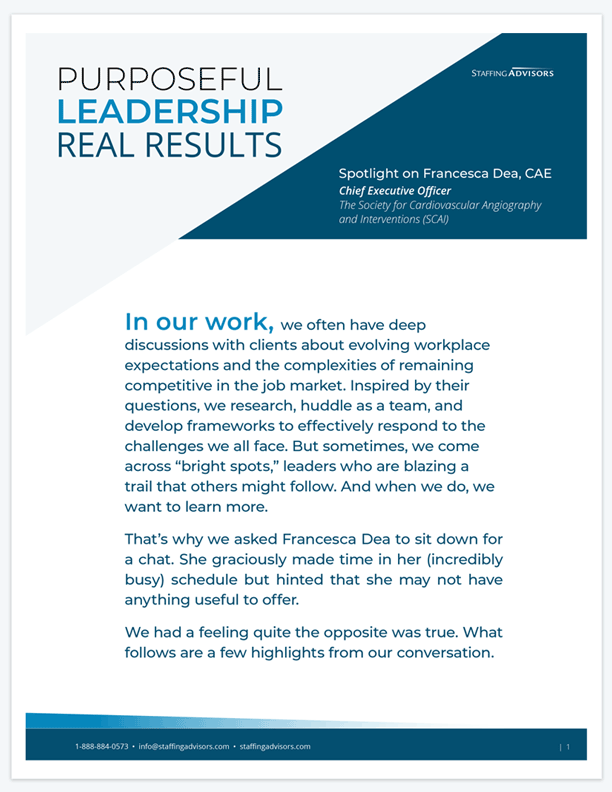In our work, we often have deep discussions with clients about evolving workplace expectations and the complexities of remaining competitive in the job market. Inspired by their questions, we research, huddle as a team, and develop frameworks to effectively respond to the challenges we all face. But sometimes, we come across “bright spots,” leaders who are blazing a trail that others might follow. And when we do, we want to learn more.
That’s why we asked Francesca Dea to sit down for a chat. She graciously made time in her (incredibly busy) schedule but hinted that she may not have anything useful to offer. We had a feeling quite the opposite was true.
What follows are a few highlights from our conversation.
A Work Culture That Drives Results
Since Francesca Dea stepped in as CEO six years ago, the Society for Cardiovascular Angiography and Interventions (SCAI) has undergone some impressive changes. The society increased annual revenue by nearly 50% and reinvigorated industry support for programs, grew staff by 300% with remarkable long-term retention, implemented a new strategic plan, pivoted to a fully remote work model, adopted a four-day workweek, deployed a new membership database, and expanded its international presence, education offerings, and scientific publications portfolio.
And those are just the initiatives that took root. There are countless other ideas the SCAI team has piloted—some that worked for a time, some that didn’t work, and others that evolved into something new. But that’s the thing about SCAI’s work culture: they are deeply driven to try, test, and tweak their way to results.
Staffing Advisors has had the pleasure of working with different team members at SCAI throughout Francesca’s tenure. What we’ve seen are happy (and high-performing) employees and candidates who are eager to join them. That’s a result of Francesca’s relentlessly agile approach and unwavering commitment to putting her team’s needs first.
The most important priority for me is making sure my team has what they need, no matter what. If I can remove any barriers and support them, they will be successful.
Creating Good Chaos
Francesca’s leadership style is anything but typical. She has a high threshold for chaos … the good kind. She doesn’t believe there is only one “right” way to reach a goal. If an opportunity presents itself, a different solution is more readily available, or an alternate approach proves to have a better return on investment, her team simply reroutes. They are still going to the same place, just changing how they get there. And she trusts her staff to map the way through.
The first time we do something, it is never going to be exactly the way we want it. We’re going to keep changing and correcting. It doesn’t mean that it didn’t work or that it was bad. It just means that it’s not going to be perfect out of the gate. You have to continually improve.
Building a Team That Thrives in Ambiguity
Francesca is the first person to say she doesn’t know it all. She hires highly-qualified people and trusts they will make the best decisions collectively. But it takes a certain type of person to thrive in the ambiguity—that good chaos—of her leadership style. Some may call it tolerance for mistakes or failure, but it’s deeper than that. It’s a culture built on continuous learning where each person has the agency to share ideas, give critical feedback (even to the CEO), and make strategic pivots without getting bogged down in administrative muck.
When hiring, Francesca and her team look for signals that candidates are intrigued by changing, dynamic organizations that don’t do the same thing twice. The people SCAI hires are excited about—and experienced at—building and scaling.
Some people are attracted to that kind of work environment and some aren’t. If a candidate wants to know exactly what their job will be day in and day out, SCAI isn’t likely a good fit for them.
I want people who are going to challenge my crazy ideas and not be afraid to say, ‘Have you lost your mind? That’s a terrible idea.’ As long as you can explain to me why, then let’s talk about it and bring new ideas. I’ve been saying that in interviews for 15 years.
Walking the Walk, Every Day
Not everyone is going to be completely comfortable challenging others’ ideas or seeing mistakes as just another path to pivot from. But Francesca and her leadership team model that behavior as much as possible and set up structures to bake it in.
Here’s how:
Each member of SCAI’s senior leadership team has their own distinct perspective and leadership style, but they all truly collaborate. Francesca helps to set the strategic direction, and her teams figure out how to get there together.
There is open communication between staff, senior leaders, and the CEO, so while everyone has the license to suggest ideas and make changes, there is enough structured information sharing to ensure everyone moves in the same direction.
SCAI holds all-staff meetings about every two weeks with some type of collaborative element—brainstorming, education, etc. Different staff members are encouraged to share what they are working on and what they’ve learned. They both teach and get feedback from the group.
SCAI holds three in-person staff retreats every year where they talk about strategy, discuss what everyone is working on, and share feedback. These retreats also have a social day organized by a group of staff volunteers. This can be anything from picking crabs together and a day of games and karaoke to volunteer work in the community.
Every year, staff fill out a culture survey administered by an outside HR company that anonymizes the responses. About a third of the questions serve as a 360-performance evaluation of Francesca; the rest are pointed questions about the culture. And SCAI’s leadership team follows up on every question or comment, whether that’s generating plans for a great idea or explaining why something won’t work just yet. Staff weigh in, and SCAI’s leadership takes immediate action. Not every idea is implemented, but every person is heard.
Going Remote and Never Going Back
Francesca had been exploring the possibility of a fully remote model before the pandemic hit. But a decision that was perhaps five years out became immediate. After a year and a half of pandemic-imposed remote work, gathering staff feedback from the culture survey, and doing homework on how to make the shift permanent, SCAI closed its office doors.
I had already read a lot of books about fully remote companies and how to do it. My gut told me that going fully remote was where we were going to end up anyway, so I decided it was the right time. I saw the value of flexibility and time and money savings for my team. To me, the list of individual benefits was long. Like being able to eat healthier and having time to work out, cook dinner and eat with your family. Or not having to pay for coffee, lunch, gas, and dry cleaning. In weighing the benefits against the challenges of remote work, it was an easy decision—it was about my team’s quality of life and happiness.
The transition wasn’t all smooth sailing. Francesca describes the work as a game of whack-a-mole.
Here is an example:
Because there would no longer be office pop-ins or casual catchups on a project, SCAI’s leadership had to be more intentional about making sure every key stakeholder was included at the right time for each project. And that meant a lot more conference calls for staff; people were struggling to find time for actual work.
On the advice of an outside consultant, Francesca pitched a “no internal calls” week for most months. Ad-hoc calls were fine, but nothing formal. Her leadership team talked about it, poked holes to see what might not work, and then shared with the entire staff to get their feedback and poke more holes.
After the first month of implementation, staff surveys showed overwhelmingly positive support. They learned some things, made adjustments, and were ready to roll with month two.
For SCAI, fully remote was the path that met their needs best. And they are making it work through rigorous testing, gathering (and acting on) staff feedback, and tweaking as needed. Every organization is unique. Other CEOs may work these types of problems and come out with a completely different approach. But the value is in what drives the decision-making: ensuring staff are engaged, happy, and equipped to do what they do best.
I think it has a lot to do with your leadership style but also really knowing the people on your team. Not every team is going to thrive in a fully remote work environment. The type of people I hire are highly motivated and self-driven—they love the autonomy. So that may contribute to why it works so well for us.
Creating Employee-Centered Schedules
The four-day work week—or compressed schedule—was another major shift in SCAI’s culture. Francesca has implemented a summer season four-day week for every team she’s worked with since the 90s. She was no stranger to how it could work and saw the benefit at SCAI. And so did her team.
With weekday meetings that regularly dipped into the evening, some staff struggled with getting that time back, even with flexible hours. Offering a year-round four-day workweek allowed everyone to make their schedules work for their individual needs.
Here’s how it works:
SCAI’s flexible hours are (and have been) on the honor system. If an employee works late one night and can take an hour the next day, they are free to do so. They just have to let their supervisor or team know.
The four-day workweek is available to anyone who would like to take it. Some staff want to work longer hours to have a longer weekend. And others don’t. It’s up to them to choose.
Most staff who participate take Fridays, but not through any mandate. It’s just what makes sense for their workflow.
It’s worth noting that SCAI’s work policies are living, breathing documents. They keep a running list of frequently asked questions and regularly update the information so staff have a consistently up-to-date reference.
Giving the Team What They Need and Getting Out of Their Way
Francesca is an informal leader who values people and ideas over hierarchy. Every staff member at SCAI has something to teach and something to learn. And with the autonomy to do so within an environment of continuous improvement, they consistently deliver the business results SCAI needs to grow.
It’s like this: giving direction without micromanaging how we get there. I let the people who are doing the work—and know the most about how it’s going to impact the member experience—figure out the best approach. My job is to guide the strategic direction, make sure staff have what they need, and that we’ve created the right culture. Everything else just comes. If my team trusts in the support, they’ll have the enthusiasm and motivation to do a great job and be successful.
Take It With You
Download a pdf of this article to share with your team. (No signup or email required.)

